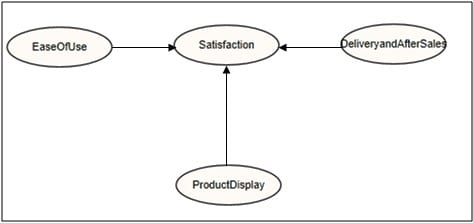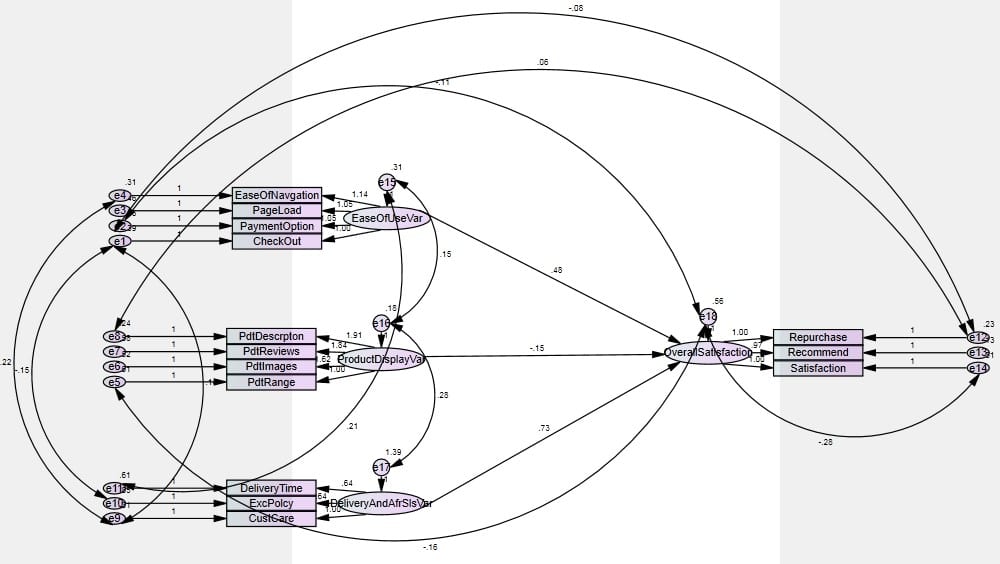To determine the critical factors which lead to overall satisfaction in on-line shopping experience an empirical research was undertaken with a survey questionnaire as the research instrument.
Conceptual model
Figure 1: Conceptual Model
The conceptual model portrays the following hypotheses which would need to be validated using structural equation modelling.
Hypothesis-1: Ease of using an online shopping portal is positively related to the overall satisfaction experienced by a customer while shopping online
Hypothesis-2: Quality of product display is positively related to the overall satisfaction experienced by a customer while shopping online
Hypothesis-3: Price of products sold via online shop is positively related to the overall satisfaction experienced by a customer while shopping online
Hypothesis-4: Quality of delivery of product and after sales service are positively related to the overall satisfaction experienced by a customer while shopping online
The structural equation modelling would need the following latent constructs and the associated manifest/ indicator variables as given below.
Latent constructs in the model and the associated manifest/ indicator variables
- Ease of use is explained by
- Ease of navigation: Ease with which a customer is able to find/browse a desired product using the online shopping portal
- Page load time: Time taken to display the website by the browser
- Payment options: Cash on delivery, Net banking, Credit card, etc.
- Check-out-process: Ease with which a customer is able to place an order once he/she has selected the product
- Quality of product display is explained by
- Product description: Text description giving details of the product
- Product review: Reviews about the product by existing customers
- Product images: Quality of image of the products
- Range of products: Number of products offered by the online shopping portal
- Price is explained by
- Price of product: Online price of a product
- Shipping cost: Cost of delivering the product to designated place, which is charged to the customer
- Coupons and discounts: Regular or seasonal discounts and coupons which can be utilised for shopping
- Quality of delivery and after sales is explained by
- Customer service: Experience of talking with a customer service executive while resolving a query
- Exchange/return policy: Ease with which a customer can return a product if the delivered product is faulty
- On-time delivery: Punctuality of delivering a product
- Overall satisfaction is explained by
- Recommendation
- Repurchase
- Satisfaction
The manifest/indicator variables were measured from the survey responses to the questionnaire.
Methodology
Structural Equation Modelling (SEM) is used to confirm the stated hypothesis of the conceptual model. The final sample size was obtained as 98, margin of error of 10%.
Data analysis
Structural Equation Modelling
To run a structural model as presented by the conceptual model, an online survey was designed to capture the responses of online shoppers. A database of 98 responses was prepared based on the data collected using survey.
Cronbach’s Alpha reliability test was performed to check whether the stated indicator variables are able to measure the same construct.
| Reliability Analysis | |
| Construct Name | Cronbach’s Alpha |
| Ease of use | 0.803 |
| Product Display | 0.804 |
| Price | 0.622 |
| Delivery & After sales | 0.807 |
| Satisfaction | 0.939 |
After reliability test it was found that ‘price’ was not being measured reliably by its indicator variables (price of product, shipment cost and coupons&discounts) as its Cronbach’s alpha value is less than 0.7. Thus the latent construct ‘price’ was not included in SEM.
Modified model
Figure 2: Revised Conceptual Model based on Cronbach’s Alpha values.
IBM SPSS AMOS (version 21) was used to test the conceptual model
Results from structural equation modelling.
Results from running SEM (using AMOS v21)
Indicators of model fit:
Chi square/degrees of freedom = 1.122
Overall model p-value = 0.236
GFI = 0.914
AGFI = 0.857
CFI = 0.991
NFI = 0.99
| SEM | ||||||
| LatentConstructsInModel | CMIN/DF | P value | CFI | GFI | AGFI | NFI |
| Good Fit | 0 <= 2 | .05 <=1 | .97 <= 1 | .95 <= 1 | .9 <= 1 | .95 <= 1 |
| Acceptable Fit | 2 <= 3 | .01 <=.05 | .95<= .97 | .9 <= .95 | .85 <= .9 | .9 <= .95 |
| EaseOfUse | 1.122 | 0.236 | 0.991 | 0.914 | 0.857 | 0.923 |
| Product Display | ||||||
| Delivery & After sales | ||||||
| Satisfaction | GoodFit | GoodFit | GoodFit | NotGoodFit | NotGoodFit | AcceptableFit |
The model fit was good considering the values of CMIN/DF, p-value, CFI and NFI, we can now proceed to have a look at the estimates weights and their levels of significance.
Conclusion
Looking at the above estimates we can conclude that:
- Quality of timely delivery and after sales significantly affect the overall satisfaction experienced by a customer while shopping online (Critical Ratio = 6.171 > 1.96, individual p-value is *** indicating highly significant).
- Ease of using an online shopping portal is positively related to the overall satisfaction experienced by a customer while shopping online. We can conclude this hypothesis but with caution (Critical Ratio = 1.909 < 1.96, individual p-value is.056 indicating somewhat significant relationship).
- Quality of product display is not positively related to the overall satisfaction experienced by a customer while shopping online (Critical Ratio = -.369 < 1.96, individual p-value is .712 indicating not significant relationship).
The above observations are incorporated in the final model where solid lines show significant relationship dotted line indicates a relationship which is not significant.
Thus from SEM analysis it was found that the below two hypothesis are correct.
H-1: Ease of using an online shopping portal is positively related to the overall satisfaction experienced by a customer while shopping online
H-4: Quality of delivery of product and after sales service are positively related to the overall satisfaction experienced by a customer while shopping online
Figure 4: Final Model as seen in the AMOS output.
References
- http://articles.economictimes.indiatimes.com/2008-01-08/news/27719779_1_middle-class-spending-marketers
- http://www.thehindu.com/sci-tech/technology/internet/india-has-slowest-internet-penetration-growth-in-apac/article6085420.ece
- http://www.ey.com/IN/en/Industries/Technology/Re-birth-of-e-Commerce-in-India
- Services Marketing: Integrating Customer Focus Across the Firm (Valarie A Zeithalm, Mary Jo Bitner, Dwayne D. Gremler and Ajay Pandit)
- http://www.academia.edu/1003804/E-Service_Quality_A_Conceptual_Model
- Jukka Ojasalo,Laurea University of Applied Sciences, Finland
- http://www.iosrjournals.org/iosr-jbm/papers/vol3-issue4/E0343440.pdf
- Dineshkumar, P.Vikkraman
The post A Structural Equation Modelling Approach to Analyse Factors Affecting on-line Shopping Experience. appeared first on Analytics India Magazine.





